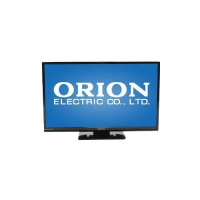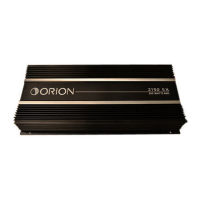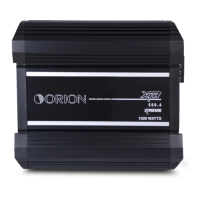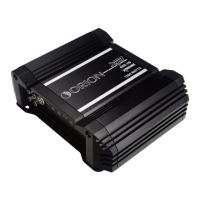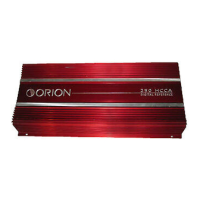Do you have a question about the Orion XTREME 1400 and is the answer not in the manual?
Defines warranty periods and lists conditions not covered, such as misuse or unauthorized modifications.
Details power output, distortion, frequency response, bandwidth, SNR, damping factor, slew rate, and sensitivity.
Details crossover types, frequency ranges, INTELLI Q boost, and the physical dimensions of the amplifiers.
Details the purpose of each component on the end panel, from power LED to power connections.
Describes six different phase switch combinations for stereo, mono, and bridged operation.
Details how to adjust input sensitivity from 200mV to 5Vrms for optimal system integration.
Explains the 'COPY', 'GAIN', and 'MASTER' modes for routing signals via AUX RCA outputs.
Details the low-pass crossover, its bypass function, and variable frequency adjustment from 45 Hz to 5 kHz.
Explains setting the high-pass crossover for midrange and tweeter speakers in the 'HIGH' frequency range.
Details using the high-pass crossover in the 'LOW' frequency range as a subsonic filter for subwoofers.
Provides recommendations for INTELLI Q boost levels (0dB, +3dB, +6dB, +10dB) for different subwoofer enclosures.
Details how to connect and use the RGC-1 for remote gain control and multi-amp setups.
Shows how to connect power and ground wires, including fuse size recommendations for specific models.
Outlines the dual 4 gauge power and ground inputs and necessary wiring for the XTR 1400.
Explains impedance, RCA input connection, phase switch settings, and gain control for stereo operation.
Details impedance, RCA inputs, phase switches, gain controls, and output configuration for bridged mode.
Explains using a single RCA input, phase switches, and gain control for mono bridged output.
Details impedance, RCA inputs, phase switches, gain controls, and output configuration for tri-mode operation.
Lists the essential and recommended tools required for performing amplifier installation.
Covers passenger compartment, trunk, and engine compartment mounting considerations and warnings.
Highlights critical safety measures like disconnecting the battery and avoiding damage to vehicle components.
Details steps for determining location, running wires, mounting, connecting, and setting configurations.
Warns against exceeding the recommended fuse size to prevent warranty voiding and damage.
Outlines steps for checking wiring, setting controls, verifying output, and troubleshooting initial issues.
Guides on adjusting source unit volume, amplifier level controls, and tone controls for undistorted output.
Details fine-tuning crossover settings and output levels for front/rear balance and woofer integration.
Lists common symptoms like no output, distorted sound, and thermal protection, with probable causes and actions.
Addresses issues like fuse blowing, poor bass response, and shorted speaker outputs with corrective actions.
Presents a step-by-step approach to diagnose noise issues, starting with muting amps and checking decks.
Guides on troubleshooting signal processors like equalizers and crossovers after isolating the source unit and amp.
Defines warranty periods and lists conditions not covered, such as misuse or unauthorized modifications.
Details power output, distortion, frequency response, bandwidth, SNR, damping factor, slew rate, and sensitivity.
Details crossover types, frequency ranges, INTELLI Q boost, and the physical dimensions of the amplifiers.
Details the purpose of each component on the end panel, from power LED to power connections.
Describes six different phase switch combinations for stereo, mono, and bridged operation.
Details how to adjust input sensitivity from 200mV to 5Vrms for optimal system integration.
Explains the 'COPY', 'GAIN', and 'MASTER' modes for routing signals via AUX RCA outputs.
Details the low-pass crossover, its bypass function, and variable frequency adjustment from 45 Hz to 5 kHz.
Explains setting the high-pass crossover for midrange and tweeter speakers in the 'HIGH' frequency range.
Details using the high-pass crossover in the 'LOW' frequency range as a subsonic filter for subwoofers.
Provides recommendations for INTELLI Q boost levels (0dB, +3dB, +6dB, +10dB) for different subwoofer enclosures.
Details how to connect and use the RGC-1 for remote gain control and multi-amp setups.
Shows how to connect power and ground wires, including fuse size recommendations for specific models.
Outlines the dual 4 gauge power and ground inputs and necessary wiring for the XTR 1400.
Explains impedance, RCA input connection, phase switch settings, and gain control for stereo operation.
Details impedance, RCA inputs, phase switches, gain controls, and output configuration for bridged mode.
Explains using a single RCA input, phase switches, and gain control for mono bridged output.
Details impedance, RCA inputs, phase switches, gain controls, and output configuration for tri-mode operation.
Lists the essential and recommended tools required for performing amplifier installation.
Covers passenger compartment, trunk, and engine compartment mounting considerations and warnings.
Highlights critical safety measures like disconnecting the battery and avoiding damage to vehicle components.
Details steps for determining location, running wires, mounting, connecting, and setting configurations.
Warns against exceeding the recommended fuse size to prevent warranty voiding and damage.
Outlines steps for checking wiring, setting controls, verifying output, and troubleshooting initial issues.
Guides on adjusting source unit volume, amplifier level controls, and tone controls for undistorted output.
Details fine-tuning crossover settings and output levels for front/rear balance and woofer integration.
Lists common symptoms like no output, distorted sound, and thermal protection, with probable causes and actions.
Addresses issues like fuse blowing, poor bass response, and shorted speaker outputs with corrective actions.
Presents a step-by-step approach to diagnose noise issues, starting with muting amps and checking decks.
Guides on troubleshooting signal processors like equalizers and crossovers after isolating the source unit and amp.
